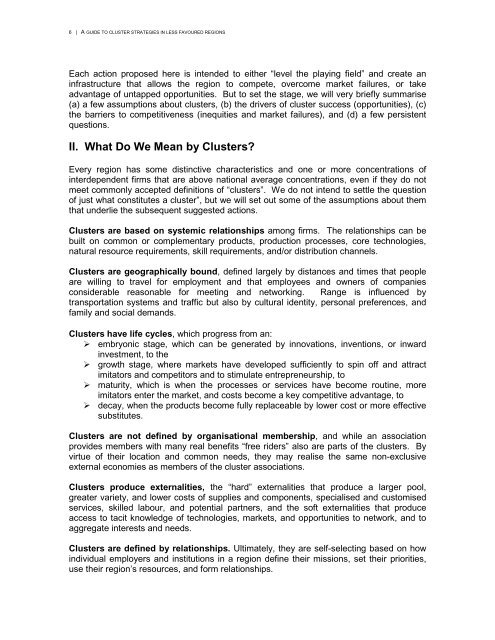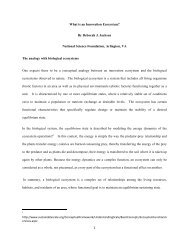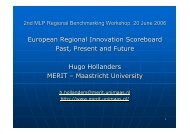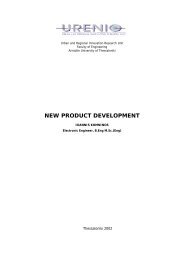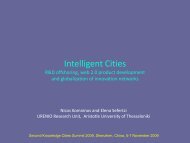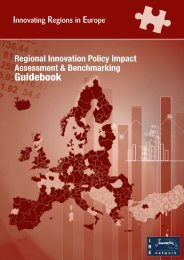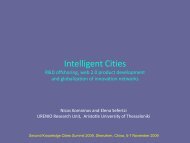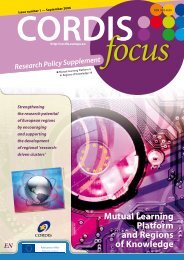Creating smart systems, guide to Cluster strategies in less favoured
Creating smart systems, guide to Cluster strategies in less favoured
Creating smart systems, guide to Cluster strategies in less favoured
Create successful ePaper yourself
Turn your PDF publications into a flip-book with our unique Google optimized e-Paper software.
6 | A GUIDE TO CLUSTER STRATEGIES IN LESS FAVOURED REGIONS<br />
Each action proposed here is <strong>in</strong>tended <strong>to</strong> either “level the play<strong>in</strong>g field” and create an<br />
<strong>in</strong>frastructure that allows the region <strong>to</strong> compete, overcome market failures, or take<br />
advantage of untapped opportunities. But <strong>to</strong> set the stage, we will very briefly summarise<br />
(a) a few assumptions about clusters, (b) the drivers of cluster success (opportunities), (c)<br />
the barriers <strong>to</strong> competitiveness (<strong>in</strong>equities and market failures), and (d) a few persistent<br />
questions.<br />
II. What Do We Mean by <strong>Cluster</strong>s<br />
Every region has some dist<strong>in</strong>ctive characteristics and one or more concentrations of<br />
<strong>in</strong>terdependent firms that are above national average concentrations, even if they do not<br />
meet commonly accepted def<strong>in</strong>itions of “clusters”. We do not <strong>in</strong>tend <strong>to</strong> settle the question<br />
of just what constitutes a cluster”, but we will set out some of the assumptions about them<br />
that underlie the subsequent suggested actions.<br />
<strong>Cluster</strong>s are based on systemic relationships among firms. The relationships can be<br />
built on common or complementary products, production processes, core technologies,<br />
natural resource requirements, skill requirements, and/or distribution channels.<br />
<strong>Cluster</strong>s are geographically bound, def<strong>in</strong>ed largely by distances and times that people<br />
are will<strong>in</strong>g <strong>to</strong> travel for employment and that employees and owners of companies<br />
considerable reasonable for meet<strong>in</strong>g and network<strong>in</strong>g. Range is <strong>in</strong>fluenced by<br />
transportation <strong>systems</strong> and traffic but also by cultural identity, personal preferences, and<br />
family and social demands.<br />
<strong>Cluster</strong>s have life cycles, which progress from an:<br />
embryonic stage, which can be generated by <strong>in</strong>novations, <strong>in</strong>ventions, or <strong>in</strong>ward<br />
<strong>in</strong>vestment, <strong>to</strong> the<br />
growth stage, where markets have developed sufficiently <strong>to</strong> sp<strong>in</strong> off and attract<br />
imita<strong>to</strong>rs and competi<strong>to</strong>rs and <strong>to</strong> stimulate entrepreneurship, <strong>to</strong><br />
maturity, which is when the processes or services have become rout<strong>in</strong>e, more<br />
imita<strong>to</strong>rs enter the market, and costs become a key competitive advantage, <strong>to</strong><br />
decay, when the products become fully replaceable by lower cost or more effective<br />
substitutes.<br />
<strong>Cluster</strong>s are not def<strong>in</strong>ed by organisational membership, and while an association<br />
provides members with many real benefits “free riders” also are parts of the clusters. By<br />
virtue of their location and common needs, they may realise the same non-exclusive<br />
external economies as members of the cluster associations.<br />
<strong>Cluster</strong>s produce externalities, the “hard” externalities that produce a larger pool,<br />
greater variety, and lower costs of supplies and components, specialised and cus<strong>to</strong>mised<br />
services, skilled labour, and potential partners, and the soft externalities that produce<br />
access <strong>to</strong> tacit knowledge of technologies, markets, and opportunities <strong>to</strong> network, and <strong>to</strong><br />
aggregate <strong>in</strong>terests and needs.<br />
<strong>Cluster</strong>s are def<strong>in</strong>ed by relationships. Ultimately, they are self-select<strong>in</strong>g based on how<br />
<strong>in</strong>dividual employers and <strong>in</strong>stitutions <strong>in</strong> a region def<strong>in</strong>e their missions, set their priorities,<br />
use their region’s resources, and form relationships.


